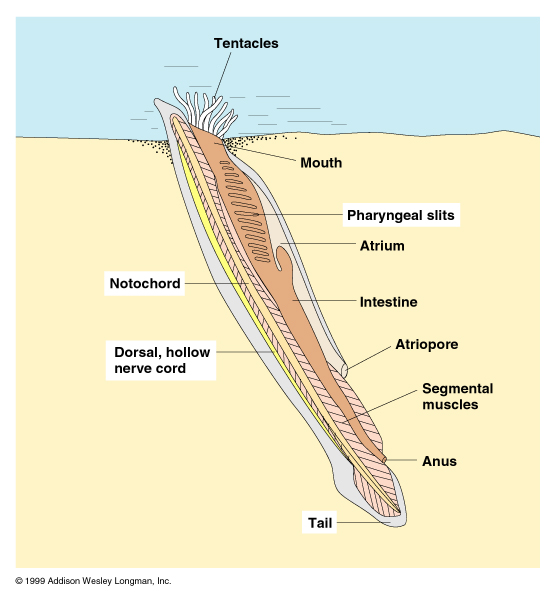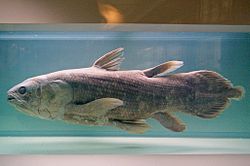Chordate Origins
4.0 / 5 based on 1 rating
- Created by: rosieevie
- Created on: 17-01-17 16:29
Chordate Phylum - Cambrian period (535mya)
- Closest relatives - Echinodermata and Hemichordata (acorn worms, pterbranchs)
- Key traits:
- Notochord
- Longitudinal flexible chord between nerve chord and digestive tube
- Large-fluid filled cells
- Maintain hydrostatic presssure, provide support and act as structure for muscles to act against
- Replaced by vetebral column in higher vertebrates
- Dorsal nerve chord (spinal column)
- Develops by invagination of dorsal ectoderm
- Hollow nerve chord develops into CNS
- Pharyngeal slits (throat slits)
- Allow water to exit body and nutrients remain - filter feeding
- Slits -> gills -> jaws -> ear bones
- Muscular post-anal tail
- No digestive tract in tail
- Propelling force -> concentration of sensory organs (cephalisation)
- Segmentation
- Only key trait if evolved independently
1 of 21
Subphylum Urochordata
Sea squirts, tunicates (2000 species)
- Either this or cephalochordata most pirimitive chordates
- Sessile filter feeders
- Adults - pharyngeal slits
- No CNS
- Larva have all other traits - disappear during metamorphosis when settles
- One group free living and retains traits
2 of 21
Subphylum Cephalochordata
Lancelets (amphioxus)
- Plankton feeders
- Burrow in sand
- Anterior tip of nerve chord swollen - brain beginnings
_11323460553942.png)

3 of 21
GROUP Craniata
- Pharyngeal slits = gill slits (no longer filter feeding)
- Neural crest cells migrate to head = cephalisation
EXTINCT - Haikouella (oldest crainiate)
- Eyes and brain
- No skull
- More fossils needed to see if brain or skull comes first
4 of 21
Class Myxini
Hagfish (30-60 species)
- Pirimative craniates
- Cartillage skull
- No jaws
- No vertebrae
- Notochord
- Scavangers or parasites
- Produces slime as defence

5 of 21
GROUP Vertebrata
- More extensive skull - still cartilage
- Vertebrae in addition to/replacing notochord
- Fin rays stiffen fins
6 of 21
Order Cephalaspidomorphi
Lampreys (35 species)
- Primitive vertebrata
- Parasites
- Cartilage skeleton
- Cartilagionous pipe around notochord - beginnings of vertebral column
7 of 21
Extinct Class Conodonts
- Abundant tooth-like fossils
- Late Cambrian to late Triassic
- Complex dental system - first instance of mineralisation
8 of 21
GROUP Gnathostomata
- Anterior gill slits = jaws
- Increasing mineralisation
- Two sets pair fins
Extinct Placoderms
- <23m long
- Big bony heads
- First instance of internal fertilisation
Extinct Acanthodians
- Smaller
- Less armoured with bony fin spines

9 of 21
Class Chondrichthyes - Sharks, rays, ratfish (750
- Mostly cartilage skeleton (suggests anscestors had bone but evolved back)
- Marine, some freshwater
Extinct Helicprion shark/ratfish
- Weird spiral mouthparts like teeth conveyorbelt
10 of 21
Class Actinopterygii - ray-finned fish (30,000 spe
- Fully mineralised endoskeleton
- Varying lifestyles
- No notochord - vertebrate instead
- Skull with lots of bones
- Swim bladder - same organ as lung
11 of 21
GROUP Sarcopterygii
- Lobe-finned fish
- Rod-shaped bones surrounded by muscles in pectoral/pelvic fins
- Yes, we're fish
12 of 21
Subclass Actinistia - the 'extinct' ones
- Thought extinct
- 2 living species near islands

13 of 21
Subclass Dipnoi - lungfish (6 species)
- Gills
- Swim bladder can act as a lung
- Survive drought in mud cocoon

14 of 21
GROUP Tetrapoda
- Limbs/feet
- Gil slit supports - ear bones
- First appeared in Devonian period
Extinct Tiktaalik
- Canadian fossil
- Croocodile fish mutant
- Intermediate both in time and physiology
Extinct Gogonausus
- ~380mya
15 of 21
Problems with Land Conquest
- Breathing (no gills)
- Drying out
- Egg fertilisation
- Embryo survival
- Body support
16 of 21
Class Amphibia - frogs, caecilians, salamanders et
- Adults live on land and breathe with lungs/skin
- Larvae live in water and breath with gills/skin
- Metamorphosis
So magical
17 of 21
GROUP Amniota
- Lungs
- Scales to protect against desication
- Membranous embryoes
- No obligatory water stage
- Early carboniferous ~345mya
- Extraembryonic membranes surround embryo water
- Egg shell protection
- Internal fertilisation
18 of 21
Class Reptilia
- Extinct parareptiles - herbivore
- Extinct pterosaurs - flight
- Extinct plesiosaurs - swim
- Extinct ichtyosaurs
- Dinosauria - dinos, birds
- Lepidosauria - snakes, lizards
- Crocodilia - crocodiles
- Testudines - turtles
19 of 21
Class Mammalia - mammals (5000+ species)
- Produce milk from modified sweat glands
- Endothermic - high metabolism
- Hair
- Mostly viviparous - live young
- 34 bones in skull - 2 main ones cranium and lower jaw (simplification)
- Tiny ear bones
Extinct Synapsidia:
- No hair
- Oviparous - lays eggs
- Dominant land tetrapods during Permian
- Few survived and evolved

20 of 21
Mammalia Groups
Monotremata - platapus and echidana
- Hair
- Produce milk from pores everywhere
- Oviparous
- Australia and New Guinea
Marsupalia - opposum, wombat, kangoroo
- Viviparous - underdeveloped young - move to pouch for second pregnancy
- Australia, South/North America
Eutheria - cats, humans, dolphins
- Placental mammals - interface between embryo and mother, feeds embryo
- Viviparous
- Embryo develops in uterus
- Woldwide because of endothermy and efficient circulatory system - environ independence
- Lrrge brain size - behavioural adaptation
- Teeth differentiation - evolutionary adaptation
21 of 21
Related discussions on The Student Room
- Classification, species concept and phylogeny - biology »
- Do we need to send EU passportor ID by post? »
- Student Finance application - further documents required »
- Unite Students Replacement Tenancy »
- Maths percentages »
- need help a few math problems »
- Spanish Student Visa help »
- Mole calculation »
- AS Maths Exponential Question »
- Postgrad Loan Application Requirements »
Similar zoology resources:
0.0 / 5
0.0 / 5
0.0 / 5
0.0 / 5
0.0 / 5
0.0 / 5
0.0 / 5
0.0 / 5
Comments
No comments have yet been made